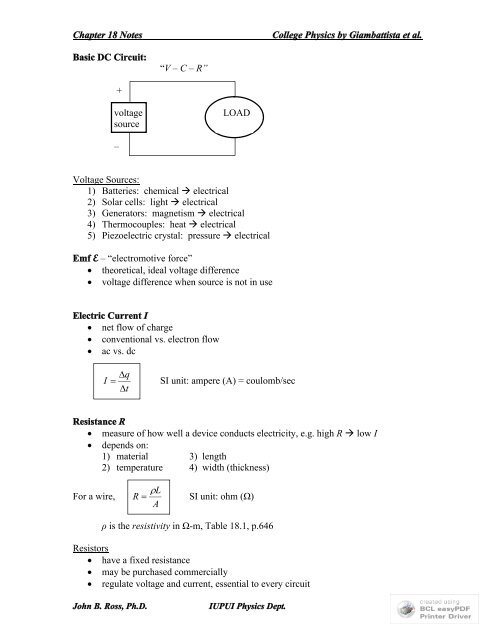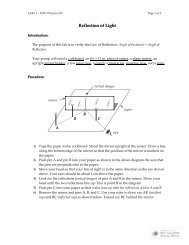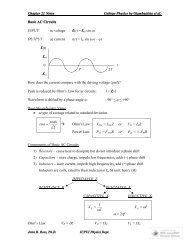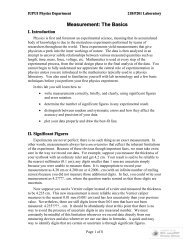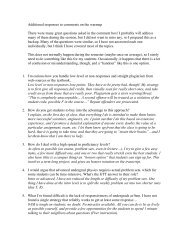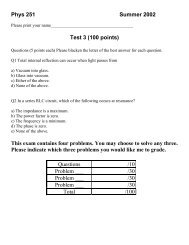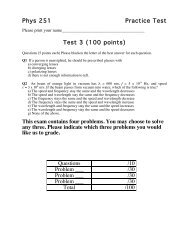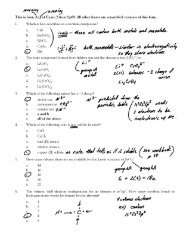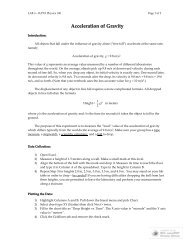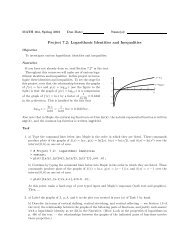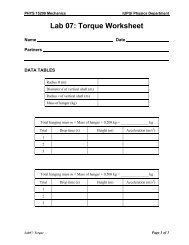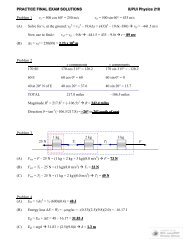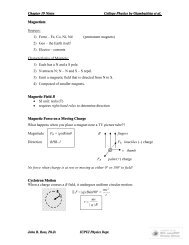Chapter 18 Notes College Physics by Giambattista et al. Basic DC ...
Chapter 18 Notes College Physics by Giambattista et al. Basic DC ...
Chapter 18 Notes College Physics by Giambattista et al. Basic DC ...
You also want an ePaper? Increase the reach of your titles
YUMPU automatically turns print PDFs into web optimized ePapers that Google loves.
<strong>Chapter</strong> <strong>18</strong> <strong>Notes</strong><br />
<strong>College</strong> <strong>Physics</strong> <strong>by</strong> <strong>Giambattista</strong> <strong>et</strong> <strong>al</strong>.<br />
<strong>Basic</strong> <strong>DC</strong> Circuit:<br />
“V – C – R”<br />
+<br />
voltage LOAD<br />
source<br />
–<br />
Voltage Sources:<br />
1) Batteries: chemic<strong>al</strong> electric<strong>al</strong><br />
2) Solar cells: light electric<strong>al</strong><br />
3) Generators: magn<strong>et</strong>ism electric<strong>al</strong><br />
4) Thermocouples: heat electric<strong>al</strong><br />
5) Piezoelectric cryst<strong>al</strong>: pressure electric<strong>al</strong><br />
Emf E – “electromotive force”<br />
theor<strong>et</strong>ic<strong>al</strong>, ide<strong>al</strong> voltage difference<br />
voltage difference when source is not in use<br />
Electric Current I<br />
n<strong>et</strong> flow of charge<br />
convention<strong>al</strong> vs. electron flow<br />
ac vs. dc<br />
I<br />
q<br />
<br />
t<br />
SI unit: ampere (A) = coulomb/sec<br />
Resistance R<br />
measure of how well a device conducts electricity, e.g. high R low I<br />
depends on:<br />
1) materi<strong>al</strong> 3) length<br />
2) temperature 4) width (thickness)<br />
For a wire,<br />
R <br />
L<br />
A<br />
SI unit: ohm (Ω)<br />
ρ is the resistivity in Ω-m, Table <strong>18</strong>.1, p.646<br />
Resistors<br />
have a fixed resistance<br />
may be purchased commerci<strong>al</strong>ly<br />
regulate voltage and current, essenti<strong>al</strong> to every circuit<br />
John B. Ross, Ph.D.<br />
IUPUI <strong>Physics</strong> Dept.
<strong>Chapter</strong> <strong>18</strong> <strong>Notes</strong><br />
<strong>College</strong> <strong>Physics</strong> <strong>by</strong> <strong>Giambattista</strong> <strong>et</strong> <strong>al</strong>.<br />
Ohm’s Law: ΔV = IR for resistors only!<br />
Termin<strong>al</strong> Voltage V t<br />
voltage difference b<strong>et</strong>ween the termin<strong>al</strong>s of a power supply when it’s in use<br />
V t = E<br />
V t = E – Ir<br />
V t = E + Ir<br />
when not in use<br />
when energy leaves battery (to power circuit)<br />
when energy enters battery (“charging”)<br />
Electric Power<br />
rate of electric<strong>al</strong> energy transfer<br />
U<br />
E qV<br />
P P = IΔV in gener<strong>al</strong> Note: watt = amp*volt!<br />
t<br />
t<br />
For resistors, ΔV = IR <br />
P = I 2 R<br />
or<br />
2<br />
V<br />
P <br />
R<br />
Joule heat formulas<br />
Question:<br />
What are you being billed for <strong>by</strong> the electric company??<br />
Energy measured in kilowatt-hours = (kilowatts)(hours) = PΔt<br />
In the SI,<br />
joules = (watts)(sec)<br />
Resistor Combinations<br />
I. Series – like a train, same current<br />
R 1 R 2 R 3 R eq = Σ R i<br />
<br />
E<br />
When one goes out, they <strong>al</strong>l go out – “open circuit”<br />
II. Par<strong>al</strong>lel – like a ladder, same voltage difference<br />
1 1<br />
<br />
R eq<br />
R i<br />
E R 1 R 2 R 3<br />
John B. Ross, Ph.D.<br />
IUPUI <strong>Physics</strong> Dept.
<strong>Chapter</strong> <strong>18</strong> <strong>Notes</strong><br />
<strong>College</strong> <strong>Physics</strong> <strong>by</strong> <strong>Giambattista</strong> <strong>et</strong> <strong>al</strong>.<br />
<br />
<br />
<br />
When one goes out, the rest stays on.<br />
More paths, more current to flow potenti<strong>al</strong> hazard!<br />
discuss fuses, circuit-breakers<br />
Short circuit – illeg<strong>al</strong> par<strong>al</strong>lel connection, path of least resistance<br />
Solving <strong>DC</strong> Circuits: Two M<strong>et</strong>hods<br />
M<strong>et</strong>hod#1 – Resistor Combinations<br />
M<strong>et</strong>hod #2 – Kirchhoff’s Rules<br />
Junction Rule: Σ I in – Σ I out = 0 at any single junction<br />
Loop Rule: Σ V rise – Σ V drop = 0 around any closed loop<br />
Solving Multiloop Circuits Using KR:<br />
1) Draw and label currents I 1 , I 2 , I 3 in each branch.<br />
2) Write termin<strong>al</strong>s on each device:<br />
3) Pick a junction and apply the Junction Rule.<br />
4) Apply the Loop Rule to two different loops.<br />
5) You have 3 equations, 3 unknowns – solve for I 1 , I 2 , I 3 .<br />
RC Circuits<br />
Have you ever used an expensive camera with a flashbulb that needs to charge before you<br />
snap the picture?<br />
I. Charging Circuit<br />
S V C (t) = E(1 – e –t/τ ) τ = RC<br />
I(t) = (E/R)e –t/τ<br />
E C<br />
max<br />
R 0 t<br />
II. Discharging Circuit<br />
S V C (t) = Ee –t/τ τ = RC<br />
I(t) = (E/R)e –t/τ<br />
R C<br />
max<br />
0 t<br />
John B. Ross, Ph.D.<br />
IUPUI <strong>Physics</strong> Dept.


